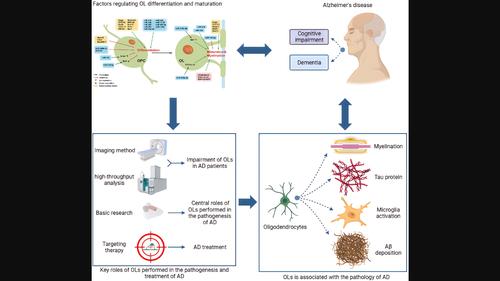当前位置:
X-MOL 学术
›
CNS Neurosci. Ther.
›
论文详情
Our official English website, www.x-mol.net, welcomes your feedback! (Note: you will need to create a separate account there.)
Recognizing Alzheimer's disease from perspective of oligodendrocytes: Phenomena or pathogenesis?
CNS Neuroscience & Therapeutics ( IF 5.5 ) Pub Date : 2024-03-22 , DOI: 10.1111/cns.14688 Jingji Wang 1, 2 , Yilan Zhen 1 , Jun Yang 1, 3 , Shaojie Yang 1 , Guoqi Zhu 1
CNS Neuroscience & Therapeutics ( IF 5.5 ) Pub Date : 2024-03-22 , DOI: 10.1111/cns.14688 Jingji Wang 1, 2 , Yilan Zhen 1 , Jun Yang 1, 3 , Shaojie Yang 1 , Guoqi Zhu 1
Affiliation

|
BackgroundAccumulation of amyloid beta, tau hyperphosphorylation, and microglia activation are the three highly acknowledged pathological factors of Alzheimer's disease (AD). However, oligodendrocytes (OLs) were also widely investigated in the pathogenesis and treatment for AD.AimsWe aimed to update the regulatory targets of the differentiation and maturation of OLs, and emphasized the key role of OLs in the occurrence and treatment of AD.MethodsThis review first concluded the targets of OL differentiation and maturation with AD pathogenesis, and then advanced the key role of OLs in the pathogenesis of AD based on both clinic and basic experiments. Later, we extensively discussed the possible application of the current progress in the diagnosis and treatment of this complex disease.ResultsMolecules involving in OLs’ differentiation or maturation, including various transcriptional factors, cholesterol homeostasis regulators, and microRNAs could also participate in the pathogenesis of AD. Clinical data point towards the impairment of OLs in AD patients. Basic research further supports the central role of OLs in the regulation of AD pathologies. Additionally, classic drugs, including donepezil, edaravone, fluoxetine, and clemastine demonstrate their potential in remedying OL impairment in AD models, and new therapeutics from the perspective of OLs is constantly being developed.ConclusionsWe believe that OL dysfunction is one important pathogenesis of AD. Factors regulating OLs might be biomarkers for early diagnosis and agents stimulating OLs warrant the development of anti‐AD drugs.
中文翻译:

从少突胶质细胞角度认识阿尔茨海默病:现象还是发病机制?
研究背景β淀粉样蛋白的积累、tau蛋白过度磷酸化和小胶质细胞激活是公认的阿尔茨海默病(AD)的三个病理因素。然而,少突胶质细胞(OLs)在AD的发病机制和治疗中也被广泛研究。目的我们旨在更新OLs分化和成熟的调控靶点,强调OLs在AD发生和治疗中的关键作用。方法本文综述首先总结了OL分化成熟与AD发病机制的靶点,然后基于临床和基础实验进一步提出了OL在AD发病机制中的关键作用。随后,我们广泛讨论了当前进展在这种复杂疾病的诊断和治疗中的可能应用。结果参与OLs分化或成熟的分子,包括各种转录因子、胆固醇稳态调节因子和microRNA也可能参与AD的发病机制。 。临床数据表明 AD 患者的 OL 受损。基础研究进一步支持 OL 在 AD 病理调节中的核心作用。此外,包括多奈哌齐、依达拉奉、氟西汀和氯马斯汀在内的经典药物在治疗AD模型中的OL损伤方面显示出其潜力,并且从OL角度出发的新疗法正在不断开发。结论我们认为OL功能障碍是AD的重要发病机制之一。调节 OL 的因素可能是早期诊断的生物标志物,而刺激 OL 的药物则需要开发抗 AD 药物。
更新日期:2024-03-22
中文翻译:

从少突胶质细胞角度认识阿尔茨海默病:现象还是发病机制?
研究背景β淀粉样蛋白的积累、tau蛋白过度磷酸化和小胶质细胞激活是公认的阿尔茨海默病(AD)的三个病理因素。然而,少突胶质细胞(OLs)在AD的发病机制和治疗中也被广泛研究。目的我们旨在更新OLs分化和成熟的调控靶点,强调OLs在AD发生和治疗中的关键作用。方法本文综述首先总结了OL分化成熟与AD发病机制的靶点,然后基于临床和基础实验进一步提出了OL在AD发病机制中的关键作用。随后,我们广泛讨论了当前进展在这种复杂疾病的诊断和治疗中的可能应用。结果参与OLs分化或成熟的分子,包括各种转录因子、胆固醇稳态调节因子和microRNA也可能参与AD的发病机制。 。临床数据表明 AD 患者的 OL 受损。基础研究进一步支持 OL 在 AD 病理调节中的核心作用。此外,包括多奈哌齐、依达拉奉、氟西汀和氯马斯汀在内的经典药物在治疗AD模型中的OL损伤方面显示出其潜力,并且从OL角度出发的新疗法正在不断开发。结论我们认为OL功能障碍是AD的重要发病机制之一。调节 OL 的因素可能是早期诊断的生物标志物,而刺激 OL 的药物则需要开发抗 AD 药物。



























 京公网安备 11010802027423号
京公网安备 11010802027423号